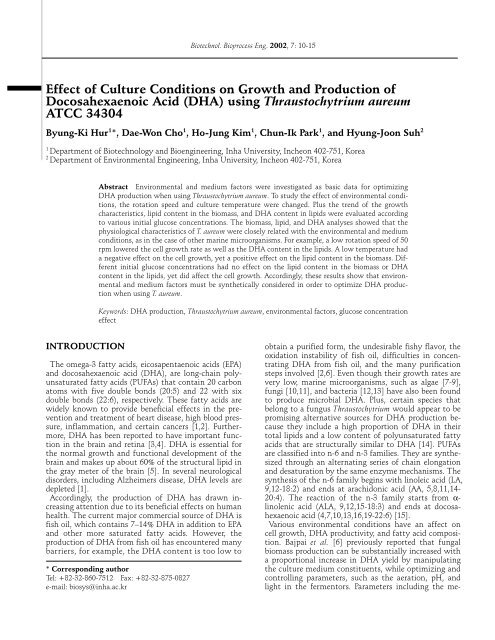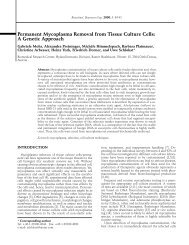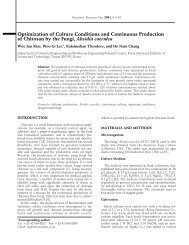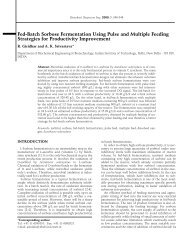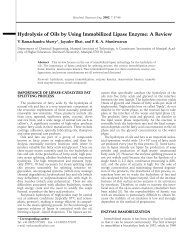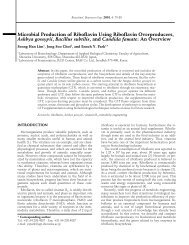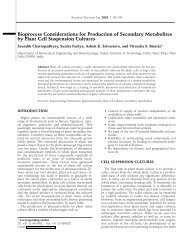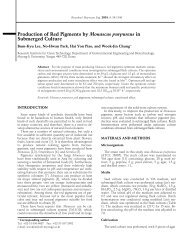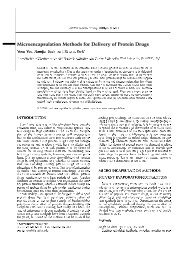(DHA) using Thraustochytrium aureum ATCC 34304 - Biotechnology ...
(DHA) using Thraustochytrium aureum ATCC 34304 - Biotechnology ...
(DHA) using Thraustochytrium aureum ATCC 34304 - Biotechnology ...
Create successful ePaper yourself
Turn your PDF publications into a flip-book with our unique Google optimized e-Paper software.
Biotechnol. Bioprocess Eng. 2002, 7: 10-15Effect of Culture Conditions on Growth and Production ofDocosahexaenoic Acid (<strong>DHA</strong>) <strong>using</strong> <strong>Thraustochytrium</strong> <strong>aureum</strong><strong>ATCC</strong> <strong>34304</strong>Byung-Ki Hur 1 *, Dae-Won Cho 1 , Ho-Jung Kim 1 , Chun-Ik Park 1 , and Hyung-Joon Suh 21Department of <strong>Biotechnology</strong> and Bioengineering, Inha University, Incheon 402-751, Korea2Department of Environmental Engineering, Inha University, Incheon 402-751, KoreaAbstract Environmental and medium factors were investigated as basic data for optimizing<strong>DHA</strong> production when <strong>using</strong> <strong>Thraustochytrium</strong> <strong>aureum</strong>. To study the effect of environmental conditions,the rotation speed and culture temperature were changed. Plus the trend of the growthcharacteristics, lipid content in the biomass, and <strong>DHA</strong> content in lipids were evaluated accordingto various initial glucose concentrations. The biomass, lipid, and <strong>DHA</strong> analyses showed that thephysiological characteristics of T. <strong>aureum</strong> were closely related with the environmental and mediumconditions, as in the case of other marine microorganisms. For example, a low rotation speed of 50rpm lowered the cell growth rate as well as the <strong>DHA</strong> content in the lipids. A low temperature hada negative effect on the cell growth, yet a positive effect on the lipid content in the biomass. Differentinitial glucose concentrations had no effect on the lipid content in the biomass or <strong>DHA</strong>content in the lipids, yet did affect the cell growth. Accordingly, these results show that environmentaland medium factors must be synthetically considered in order to optimize <strong>DHA</strong> productionwhen <strong>using</strong> T. <strong>aureum</strong>.Keywords: <strong>DHA</strong> production, <strong>Thraustochytrium</strong> <strong>aureum</strong>, environmental factors, glucose concentrationeffectINTRODUCTIONThe omega-3 fatty acids, eicosapentaenoic acids (EPA)and docosahexaenoic acid (<strong>DHA</strong>), are long-chain polyunsaturatedfatty acids (PUFAs) that contain 20 carbonatoms with five double bonds (20:5) and 22 with sixdouble bonds (22:6), respectively. These fatty acids arewidely known to provide beneficial effects in the preventionand treatment of heart disease, high blood pressure,inflammation, and certain cancers [1,2]. Furthermore,<strong>DHA</strong> has been reported to have important functionin the brain and retina [3,4]. <strong>DHA</strong> is essential forthe normal growth and functional development of thebrain and makes up about 60% of the structural lipid inthe gray meter of the brain [5]. In several neurologicaldisorders, including Alzheimers disease, <strong>DHA</strong> levels aredepleted [1].Accordingly, the production of <strong>DHA</strong> has drawn increasingattention due to its beneficial effects on humanhealth. The current major commercial source of <strong>DHA</strong> isfish oil, which contains 7–14% <strong>DHA</strong> in addition to EPAand other more saturated fatty acids. However, theproduction of <strong>DHA</strong> from fish oil has encountered manybarriers, for example, the <strong>DHA</strong> content is too low to* Corresponding authorTel: +82-32-860-7512 Fax: +82-32-875-0827e-mail: biosys@inha.ac.krobtain a purified form, the undesirable fishy flavor, theoxidation instability of fish oil, difficulties in concentrating<strong>DHA</strong> from fish oil, and the many purificationsteps involved [2,6]. Even though their growth rates arevery low, marine microorganisms, such as algae [7-9],fungi [10,11], and bacteria [12,13] have also been foundto produce microbial <strong>DHA</strong>. Plus, certain species thatbelong to a fungus <strong>Thraustochytrium</strong> would appear to bepromising alternative sources for <strong>DHA</strong> production becausethey include a high proportion of <strong>DHA</strong> in theirtotal lipids and a low content of polyunsaturated fattyacids that are structurally similar to <strong>DHA</strong> [14]. PUFAsare classified into n-6 and n-3 families. They are synthesizedthrough an alternating series of chain elongationand desaturation by the same enzyme mechanisms. Thesynthesis of the n-6 family begins with linoleic acid (LA,9,12-18:2) and ends at arachidonic acid (AA, 5,8,11,14-20:4). The reaction of the n-3 family starts from α-linolenic acid (ALA, 9,12,15-18:3) and ends at docosahexaenoicacid (4,7,10,13,16,19-22:6) [15].Various environmental conditions have an affect oncell growth, <strong>DHA</strong> productivity, and fatty acid composition.Bajpai et al. [6] previously reported that fungalbiomass production can be substantially increased witha proportional increase in <strong>DHA</strong> yield by manipulatingthe culture medium constituents, while optimizing andcontrolling parameters, such as the aeration, pH, andlight in the fermentors. Parameters including the me-
Biotechnol. Bioprocess Eng. 2002, Vol. 7, No. 1 11dium composition [1,16], carbon source, nitrogen The dried cells were weighed in a 10-mL teflon-linedsource [6], nutrient starvation [17], fatty acid precursor screw cap vial and the lipids extracted <strong>using</strong> methanoladdition [18], pH, temperature [19-21], light intensity at 60 o C for 24 h. The debris was removed by centrifuging,then the extracted lipids were dried at 30 o C under a[22], aeration and culture age [15] have all been reportedto play important roles in the biosynthesis and vacuum and weighed. The dried lipids were estrifiedaccumulation of polyunsaturated fatty acids in most with an acetyl chloride-methanol solution <strong>using</strong> themicroorganisms.method of Lepage and Roy [23]. The methyl esters wereIn the present study, the physiological characteristics dissolved in hexane and analyzed <strong>using</strong> a HewlettofT. <strong>aureum</strong>, including the cell growth, <strong>DHA</strong> production, Packard 6890 gas chromatography equipped with alipid content, and sugar uptake, were investigated as flame ionized detector (FID) and HP 19091J-413 capillarycolumn. The column temperature was raised fromfunctions of the culture temperature, rotation speed,and culture time.150 o C (2 min) to 265 o C (2 min) at 7 o C /min.MATERIALS AND METHODSMicroorganism and Culture Conditions<strong>Thraustochytrium</strong> <strong>aureum</strong> <strong>ATCC</strong> <strong>34304</strong> was purchasedfrom the American Type Culture Collection (<strong>ATCC</strong>,Rockville, MD, USA). The strain was maintained on a3% agar slant based on an artificial sea-water mediumsupplemented with yeast extract (1 g/L) and peptone (1g/L). The medium for the inocula and main culture wasthe same artificial sea-water, which was composed of 24g/L NaCl, 12 g/L MgSO 47H 20, 1 g/L CaCl 2⋅ 2H 2O, 0.75g/L KCl, 0.04 g/L NaNO 3, 0.001 g/L K 2HPO 4, 1 g/LC 4H 11NO 3, 12 mg/L Na 2EDTA, 2 mg/L ZnSO 4⋅ 7H O, 1 2mg/L NaMoO 4, 0.5 mg/L FeCl 3⋅ 6H O, 0.2 mg/L MnCl ⋅2 24H 2O, 2 µg/L CoCl 2⋅ 6H O, 2 µg/L CuSO ⋅ 5H 2 4 20, 300µg/L C 12H 17ClN 2OS ⋅ HCl, 20 µg/L H 2NC 6H 4COOH, 10µg/L C 18H 32CaN 2O 10, and 4 µg/L cyanocobalamin. Inaddition, glucose was used as the carbon source andyeast extract and peptone as the nitrogen sources. Theconcentrations of the nitrogen sources were fixed at 1g/L for the yeast extract and 1 g/L for the peptone forall cultures, whereas the carbon source concentrationwas varied between 5 g/L and 35 g/L to investigate theeffect of the concentration on the physiological characteristicsof T. <strong>aureum</strong>.The inocula were prepared in 250-mL Erlenmyer flaskscontaining 50 mL of the medium, and were grown at24 o C for 48 h with orbital shaking at 100 rpm. Then theproduction cultures were performed <strong>using</strong> the 48 h inoculumat a rate of 5%(v/v). in 250-mL Erlenmeyerflasks containing 60 mL of the medium over 7 days. Thecultivation temperature was changed from 4 o C to 32 o Cand the rotation speed from 50 rpm to 200 rpm. Samplingswere carried out every 24 h to analyze the drycell weight, glucose consumption, lipid content, and<strong>DHA</strong> production.Analytical MethodsThe dry weight of the biomass was determined bycentrifuging a known volume of the fugal cell suspension,washing the cells with distilled water two or threetimes, and drying them at 70 o C for more than 20 h. Theglucose concentration was then determined <strong>using</strong> a glucoseanalyzer (TOA, GLU-11, Japan).RESULTS AND DISCUSSIONEffect of Rotation SpeedThe biomass production patterns for various rotationspeeds (50, 100, 150, and 200 rpm) are illustrated accordingto the cultivation day in Fig. 1. At all rotationspeeds, the biomass production increased with the cultivationday, yet the maximum biomass concentrationwas achieved with 100 rpm compared with the otherrotation speeds.The effect of the rotation speed on the lipid content inthe biomass and <strong>DHA</strong> content in the lipids is presentedin Fig. 1. The lipid content was higher in the order of200, 100, 150, and 50 rpm.However, the differences in the lipid production in thecells between the rpms were too small to conclude thatrotation speed had a specific effect on the production.The rotation speed did have a slight affect on the <strong>DHA</strong>content in the lipids. Which was higher in the order of150, 200, 100, and 50 rpm. In the case of 50 rpm, the<strong>DHA</strong> content was much lower compared to that withthe other rpms. When the rotation speed was changedfrom 100 to 200 rpm, the difference in the <strong>DHA</strong> contentaccording to the rpm was minimal.Bajapai et al. used a rotation speed of up to 300 rpm toculture the same strain, T. <strong>aureum</strong> [6]. However, a rotationspeed higher than 250 rpm disrupted the cells, sothat the morphology was found to be severely changedand the <strong>DHA</strong> content also greatly reduced. As such,since the <strong>DHA</strong> content in lipids would appear to besignificantly affected by shear force, the agitation speedis seemingly a key factor for optimal <strong>DHA</strong> production.Table 1 represents the various yields defined by Eqs. (1)to (4). Every value was calculated on the basis of fivedays of cultivation.YYLYX /SL / XD/XD/L= ( X5day− X0)/(S0− S5day)= ( L5day− L0)/( X5day− X0)= ( D − D0)/( X − X0)5day5day= ( D − D0)/( L − L0)5day5day(1)(2)Where, X, S, D, and L are the biomass, glucose, <strong>DHA</strong>and lipid concentration. The subscripts 5 day and 0,(3)(4)
12 Biotechnol. Bioprocess Eng. 2002, Vol. 7, No. 1Fig. 1. Effect of rotation speed on biomass production (a),lipid content in biomass (b), and <strong>DHA</strong> content in lipid (c). !,50 rpm ; ", 100 rpm ; !, 150 rpm ; ×, 200 rpm.mean after 5 days of cultivation and before cultivationrespectively.The biomass yield, Y X/S, ranged from 0.37 to 0.48, thelipid yield to biomass, Y L/X, from 0.53 to 0.66, and the<strong>DHA</strong> yield to biomass, Y D/X, from 0.046 to 0.054. In thecurrent study the various yields exhibited no increasingor decreasing trend with an increase in the rotationspeed. The effect of the temperature and glucose concentrationon the physiological characteristics of T.<strong>aureum</strong> was also investigated to ensure maximum cellgrowth and stable <strong>DHA</strong> production when fixing therotation speed at 100 rpm.Fig. 2. Effect of cultivation temperature on biomass productionpatterns (a), lipid content in biomass (b), and <strong>DHA</strong> contentin lipids (c). !, 4 o C; ", 11 o C; !, 18 o C; ×, 24 o C; #, 32 o C.Effect of Cultivation TemperatureThe cultivation temperatures considered in the currentstudy were 4, 11, 18, 24, and 32 o C. The cultivation wascarried out for 7 days. However, in the case of 4 o C, thecultivation was continued for 14 days because the cellgrowth was too slow. The growth profiles observed atdifferent temperatures are illustrated in Fig. 3. Thebiomass concentration relative to the cultivation dayincreased up to the fourth day, yet thereafter, the cellgrowth reached the stationary phase. When the cultivationtemperatures were 4 and 11 o C, the growth was
Biotechnol. Bioprocess Eng. 2002, Vol. 7, No. 1 13Table 1. Yield of biomass, lipid, <strong>DHA</strong> according to various Table 2. Yield of biomass, lipid, <strong>DHA</strong> according to variousrotation speeds (five days of cultivation)cultivation temperatures (five days of cultivation)Rotation speed Y X/SY L/XY D/LY D/X50 rpm100 rpm150 rpm200 rpm0.37850.38990.36570.48370.06890.09400.06920.09140.66480.52860.65720.58500.04580.04970.04550.0535Cultivationtemperature4 o C11 o C18 o C24 o C32 o CY X/SY L/XY D/LY D/X0.76810.72470.37360.38990.44110.33740.36560.17710.09400.10840.61530.41090.43170.52850.41560.20760.15020.07640.04970.0450Table 3. Effect of initial glucose concentration on biomass,lipid, <strong>DHA</strong> yields and the sugar conversion ratioInitial glucoseconcentration(g/L)Biomass yieldLipid yield<strong>DHA</strong> yieldSugar conversionratio5 8 11 14 17 23 29 350.330 0.360 0.362 0.388 0.348 0.316 0.340 0.3870.371 0.394 0.439 0.472 0.550 0.705 0.810 0.7330.224 0.246 0.233 0.225 0.186 0.199 0.182 0.2800.937 0.971 0.913 0.768 0.735 0.612 0.530 0.405Fig. 3. Effect of initial glucose concentration on the cellgrowth of T. <strong>aureum</strong>. !, 5 g/L ; ", 8 g/L ; !, 11 g/L ; X, 14g/L ; # 17 g/L ; $ 23 g/L ; +, 29 g/L ; −, 35 g/L.very slow and also stopped after the fourth day. Thebiomass production patterns at 4 and 11 o C were verysimilar to each other, yet quite different from the patternsat 18, 24, and 32 o C. However, the differencesamong 18, 24, and 32 o C were too small to be distinguished.According to the previous report by Bajapai et al. [6],the biomass concentration increased relative to thetemperature and reached a maximum value at 28 o C.Therefore, they investigated other culture characteristicsat 28 o C. Meanwhile Yokochi et al. [14] also foundthat the growth of Schizochytrium limacium SR21 was afunction of the cultivation temperature, where the optimumtemperature was 25 o C. Other marine microorganismsare also affected by the cultivation temperatureand show different optimum temperatures for themaximum biomass [15].The effect of the cultivation temperature on the lipidcontent in the biomass and <strong>DHA</strong> content in the lipids ispresented in Fig. 3, respectively the lipid content becamehigher with a decrease in the cultivation temperature(Fig. 3).Bajapai et al. [6] also reported the same trend wherethe lower the temperature, the higher the lipid content.The <strong>DHA</strong> content in the lipids was not significantlyaffected by the cultivation temperature compared withthe lipid content in the biomass and remained almostconstant throughout the culture period (Fig. 3).Table 2 represents the values of the four differentyields defined by Eq. (1) at various cultivation tempera-tures. The lipid yield, Y L/X, increased with a decrease inthe cultivation temperature and became at 0.34 at 4 o C.The <strong>DHA</strong> yields, Y D/Land Y D/X, showed the same tendencyas the lipid yield.Effect of Initial Sugar ConcentrationThe effect of the initial glucose concentration on thelipid content in the biomass, <strong>DHA</strong> content in the lipids,biomass yield, lipid yield, and <strong>DHA</strong> yield was investigatedwithin a range of 5 g/L to 35 g/L of glucose.The effect of the initial glucose concentration on thebiomass production of T. <strong>aureum</strong> is shown in Fig. 3. Thebiomass increased relative to the cultivation day withall initial glucose concentrations. The initial glucoseconcentration exhibiting the highest biomass at the endof the culture was 29 g/L with a biomass value of 4.5g/L. The biomass yields with the various initial glucoseconcentrations and sugar conversion ratios are illustratedin Table 3, as defined by Eqs. (5) and (6) respectively.YYx /sS/So∆X=∆S∆S=SoHere, ∆X is the difference between the biomass concentrationson the seventh day and the initial day of cultivation,and ∆S is the difference between the sugar concentrations.As shown in Table 3, the biomass yield remainednearly constant, regardless of the initial sugarconcentration. However, the sugar conversion ratio decreasedaccording to the increase in the initial sugar con-(5)(6)
14 Biotechnol. Bioprocess Eng. 2002, Vol. 7, No. 1nearly constant, regardless of the initial glucose concentration.CONCLUSIONFig. 4. (a) Effect of initial glucose concentration on lipid contentin biomass after 7 days of cultivation. (b) Effect of initialglucose concentration on <strong>DHA</strong> content in lipids after 7 daysof cultivation.centration. Many researchers have attempted to optimizethe medium composition and environmental factorswith a fixed initial sugar concentration [6,14,24].As such, there are quite a few reports on the effect ofthe initial sugar concentration on the culture characteristics.The lipid and <strong>DHA</strong> contents at the end of the cultureare presented in Fig. 4. The lipid content in the biomassremained around 13%, regardless of the initial sugarconcentration, while the <strong>DHA</strong> content in the lipids alsoremained nearly constant at 40%.The lipid and <strong>DHA</strong> yields, as defined by Eqs. (7) and(8), are also illustrated in Table 3.mgY =∆L( ×1L/S ∆ S g 100mgY =∆D( ×D/S ∆ S g)1100)Where ∆L, ∆S, and ∆D represent the difference betweenthe seventh day concentration and the initial concentrationfor the lipids, glucose, and <strong>DHA</strong>, respectively. Asshown in Table 3, the <strong>DHA</strong> and lipid yields remained(7)(8)The effect of the initial concentration, cultivationtemperature, and rotation speed on the growth, lipidproduction, and <strong>DHA</strong> production characteristics wasinvestigated.The growth of T. <strong>aureum</strong> exhibited a significantrelationship with the rotation speed and was found tobe very sensitive to the shear force. The cell growth wasoptimal around 100 rpm. The effect of the rotationspeed on the lipid content in the biomass was minimal,yet the <strong>DHA</strong> content in the lipids was significantly reducedwith a low rotation speed of 50 rpm. Changingthe rotation speed from 100 to 200 rpm had no obviousaffect on the <strong>DHA</strong> content. The conversion rates (Y X/S,Y L/X, Y D/X, Y D/L) also remained unchanged with rotationspeeds within a range of 50 to 200 rpm.As the cultivation temperature was lowered, the lipidand <strong>DHA</strong> contents in the biomass increased, yet thebiomass production became lower. The cultivationtemperature had a significant effect on growth, thelipid content in the biomass, and <strong>DHA</strong> content in thelipids. In the case of a cultivation temperature of 4 and11 o C the growth was very slow and stopped after thefourth day at which point the final biomass was lessthan 0.5 g/L. The growth with cultivation temperaturesof 18, 24, and 32 o C was very similar. However, the lipidcontent in the biomass and <strong>DHA</strong> content in the lipidsincreased according to a decrease in the temperature. Itwas found that a low temperature induced more lipidand <strong>DHA</strong> accumulation in the biomass, as such, theoptimal temperature for cell growth was not the bestcondition for lipid and <strong>DHA</strong> production.The biomass increased with the cultivation period,regardless of the initial glucose concentration. At a lowglucose concentration below 8 g/L, a dependency of thecell growth on the initial glucose concentration appeared,and similar growth curves were also found witha higher glucose range. The biomass yields remainednearly constant, irrespective of the initial glucose concentration,yet the sugar conversion ratio decreasedwith an increase in the initial glucose concentration.This reflects the inappropriateness of the medium compositionat a high glucose concentration, which will beinvestigated in a further study. The lipid content in thebiomass and <strong>DHA</strong> content in the lipids remained almostconstant, regardless of the initial glucose concentration.Accordingly, the current study demonstrated that thegrowth of T. <strong>aureum</strong>, its lipid content, and <strong>DHA</strong> contentare partially or completely affected by environmentaland medium factors, therefore these factors must besynthetically considered in order to optimize <strong>DHA</strong> productionwhen <strong>using</strong> T. <strong>aureum</strong>.
Biotechnol. Bioprocess Eng. 2002, Vol. 7, No. 1 15Acknowledgements This work was supported by aspecial program for the development of <strong>Biotechnology</strong>and Bioprocess Engineering at Inha University.REFERENCES[1] Singh, A. and O. P. Ward (1996) Production of high yieldsof docosahexaenoic acid by <strong>Thraustochytrium</strong> roseum<strong>ATCC</strong> 28210. J. Ind. Microbiol. 12: 370-373.[2] Ward, O. P. (1995) Microbial production of long-chainPUFAs. INFORM 6: 683-688.[3] Bazan, N. G., T. S. Reddy, H. E. P. Bazan, and D. L. Brikle(1986) Metabolism of arachidonic and docosahexaenoicacid in the retina. Prog. Lipid Res. 25: 595-606.[4] Uauy, R. D., D. G. Brich, E. Z. Brich, J. E. Tyson, and D.R. Hoffman (1990) Effect of dietary omega-3 fatty acidson retinal function of very-low-brith-weight neonates.Pediar. Res. 28: 485-492.[5] Connor, W. E., N. Martha, and D. S. Lin (1990) Dietaryeffects on brain fatty acid composition, the reversibilityof n-3 fatty acid deficiency and turnover of doecosahexaenoicacid in brain, erythrocyte and plasma of rhesusmonkey. J. Lipid Res. 31: 237-247.[6] Bajpai, P. K., P. Bajpai, and O. P. Ward (1991) Optimizationof production of docosahexaenoic acid (<strong>DHA</strong>) by<strong>Thraustochytrium</strong> <strong>aureum</strong> <strong>ATCC</strong> <strong>34304</strong>. JAOCS 68: 509-514.[7] Jseph, J. D. (1975) Identification of 3, 6, 9, 12, 15-octadecapentaenoic acid in laboratory-cultured photosyntheticdinoflagellates. Lipids 10: 395-403.[8] Patton, S., G. Fuller, A. R. Loehlich, and A. A. Benson(1966) Fatty acids of the ‘red tide’ organism Gonyaulaxpolyedra. Biochem. Biophys. Acta 116: 577-579.[9] Withers, N. W. and J. C. Nevenzel (1977) Phytyl esters ina marine diflagellate. Lipids 12: 989-993.[10] Tyrrell, D. (1967) The fatty acid composition of in Entomophthoraisolates. Can. J. Microbiol. 13: 755-760.[11] Shaw, R. (1965) The occurrence of gamma-linolenic acidin fungi. Biochem. Biophys. Acta 98: 230-237.[12] DeLong, E. F. and A. A. Yayanos (1986) Biochemical functionand ecological significance of novel bacterial lipid indeep-sea prokaryotes. Appl. Environ. Microbiol. 51: 730-737.[13] Yano, Y., A. Nakayama, H. Saito, and K. Ishihara (1994)Production of docosahexaenoic acid by marine bacteriaisolated from deep sea fish. Lipids 29: 527-528.[14] Yokochi, T., D. Honda, T. Higashihara, and T. Nakahara(1998) Optimization of docosahexaenoic acid productionby Schizochytrium limacium SR21. Appl. Microbiol. Biotechnol.49: 72-76.[15] Wichien, Y. M. and P. W. Owen (1989) Omega-3 fattyacids: Alternative sources of production. Process Biochem.24: 117-125.[16] Sajbidor, J., S. Dobronova, and M. Certik (1990) Arachidonicacid production by Mortiesella sp. S-17. Influenceof C/N ratio. Biotechnol. Lett. 12: 455-456.[17] Peberdy, J. F. and D. K. Toomer (1975) Effect of nutrientstarvation on the utilization of storage lipids in Mortiesellaramaruiana. Microbios. 13: 123-131.[18] Radwan, S. S. and A. H. Soliman (1988) Arachidonic acidfrom fungi utilizing fatty acids with short chains as solesources of carbon and energy. J. Gen. Microbiol. 134: 387-393.[19] Yue, J. and F. Chen (2000) Effects of medium glucoseconcentration and pH on docosahexaenoic acid contentof heterotrophic Crypthecodinium cohnii. Process Biochem.35: 1205-1209.[20] Neidelman, S. L. (1987) Effect of temperature on lipidunsaturation. Biotechnol. Eng. Rev. 5: 245-268.[21] Stinson, I. E., R. Kwoczak, and M. J. Kuruntz (1991)Effect of cultural conditions on production of eicosapentaenoicacid by Pythium irregulare. J. Ind. Microbiol. 8: 171-178.[22] Cohen, Z., A. Vonshek, and A. Richmond (1987) Fattyacid composition of Spirulina strains grown under variousenvironmental conditions. Phytochem. 26: 2255-2258.[23] Lepage, C. and C. C. Roy (1984) Improved recovers offatty acid a through direct of transesterification withoutprior extraction and purification. J. Lipid Res. 25: 1391-1396.[24] Iida, I., T. Nakahara, T. Yokochi, Y. Kamisaka, H. Yagi, M.Yamaoka, and O. Suzuki (1996) Improvement of docosahexaenoicacid production in a culture of <strong>Thraustochytrium</strong><strong>aureum</strong> by medium optimization. J. Ferment. Bioeng.81: 76-78.[Received October 26, 2001; accepted February 8, 2002]


